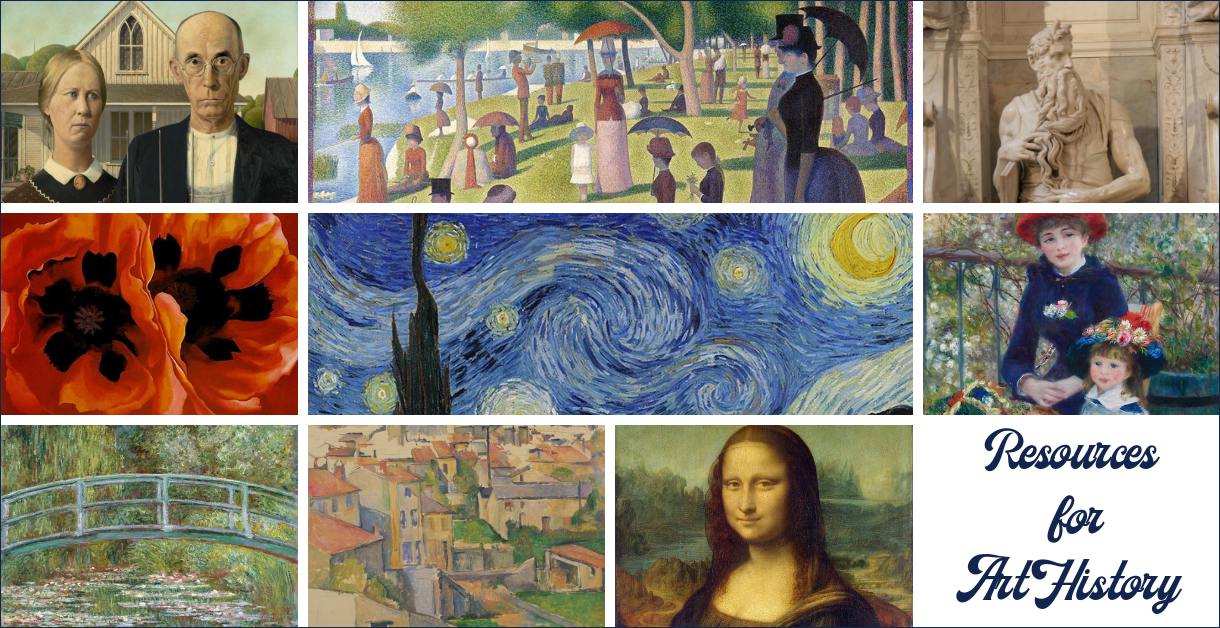Because art is all around us, not just in museums or art galleries, many homeschool families like to include art history in their studies so that children can have a better understanding of how we express ideas and other information through a visual context and how those methods and content of communication have changed through the years.
Here are a few websites that we found that you may find useful in your art history studies.
Art Access – This website from the Art Institute of Chicago helps students gain an understanding of style, content and historical context of art form different cultures and time periods. Each section includes artwork examples, lesson plans, activities, interactive maps and other suggested related resources.
Art History Teaching Resources – Search this peer-populated resource website for lesson plans, museum video introductions, book reviews, activities and more.
Garden of Praise: Famous Paintings Art Appreciation/Lessons for Kids - At this page of the larger website, learn about 48 different artists and their famous works of art. Artist pages include mini-biographies, images of artwork and an online quiz at the end of each unit.
Art Cyclopedia – There is a wealth of information at this site. You can use the search boxes to locate an artist, work of art or museum or browse through the artists by name, medium, subject, nationality, women artists, or art movement. Once an artist has been selected, there will be resource list of links to other websites for information about the artist and his/her work.
Art History Resources – Explore this extensive website created by art history expert, professor, and author, Dr. Christopher L.C.E. Witcombe, to learn about artwork categorized by either time period or location. After you have decided on an area of interest, you will find a list of available resources to expand your study.
Dick Blick Art Lesson Plans – On this page of an art supply store you will find tons of lesson plans that are sorted by grade level, including special education, and can be searched by grade level, discipline, or video lesson plans. Each plan provides easy-to-follow instructions, materials list, and an example of the completed work. Many of the lesson plans are also available as a PDF.
The Met – Educators – Lesson Plans – Use these plans to learn about a variety of works of art. Each plan includes a comprehensive breakdown of applicable subject matter, goals, standards met, and procedural information for implementation.
MetPublications – This is another page from The Met website that provides out of print art books and more that can be read online or downloaded as PDFs. Before you leave The Met, be sure to browse through the other available pages using the upper index for even more resources to use in your art studies.
Interactive Websites:
These are a few websites that provide online interactive activities for fun art exploration.
Portrait Detectives – Your kids can learn about art history by interactively studying famous portraits from the Walker Art Gallery.
A. Pintura: Art Detective – Help the art detective solve the case of Grandpa's Painting by examining artwork from famous artists and in the process learn about art concepts and artists.
Inside Art – With this other great interactive from Eduweb, students can learn about painting style, types of paintings and the use of color and brush strokes in the works of Vincent van Gogh. There are additional resources also available through the Teacher's Resources link.
Museum of Modern Art: Destination Modern Art – Geared toward younger children, this fun interactive game teaches them about modern art with the help of an "alien" museum guide. Children can click on locations in the museum, then select a piece of artwork to learn about it. Parents will also find additional activity ideas to allow their child to apply the techniques used by the artist. (Please note that Flash must be active to use this site. We used Firefox to play the game without issue.)
MetKids – Another great site from The Met, targeted for children ages 7-12, kids can explore the museum with the interactive map, watch kid-hosted videos, examine art through history and around the word with the Time Machine and much more.
Note: As always, but especially when teaching art, be sure to preview all of these websites and the content prior to allowing students to visit to determine if the content is appropriate for your family.


